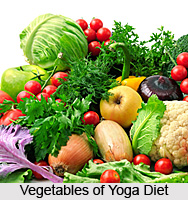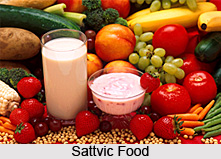 Diet plays an important role in the routine of yogic lifestyle. The ancient Yogis were well aware of the value of dietetics. The yogis knew that while food habits could condition the body and the mind, inversely, also certain physiological and psychological states could create an appetite for certain foods. To follow a Yoga diet, one need not necessarily be a Yoga practitioner; a desire to live a better life by following a diet is all required. Yoga diet has been proven over thousands of years to build strong bodies and minds.
Diet plays an important role in the routine of yogic lifestyle. The ancient Yogis were well aware of the value of dietetics. The yogis knew that while food habits could condition the body and the mind, inversely, also certain physiological and psychological states could create an appetite for certain foods. To follow a Yoga diet, one need not necessarily be a Yoga practitioner; a desire to live a better life by following a diet is all required. Yoga diet has been proven over thousands of years to build strong bodies and minds.
Irrespectively, Yoga holds the moral principle of non-violence (Ahimsa), that man really is herbivore - frugivorous animal. The ideal food for man that contributes to greater endurance comprises grains, vegetables, nuts, dairy products, fruits, honey and nutritive roots. All nutrients which are pure, pleasant, sweet, nourishing and easily digestible are generally recommended for the yogis to consume. No spices are to be used as these have been found to be invigorating and harmful. Even the use of common salt is considered as harmful to good health. Highly weathered foods and stimulating drinks are prohibited in a Yoga diet. Foods that are sharp, sour, pungent, bitter and heavy are similarly not permissible.
 Balanced Yoga Diet for the Common Men
Balanced Yoga Diet for the Common Men
The balanced Yoga diet for the common men should be spaced by an interval of four hours between each meal. Breakfast, while practicing serious Yoga asanas, may consist of milk, a little of whole wheat preparation, honey and dried or fresh fruits. At noon, lunch can be made of a vegetable soup, preparations from grains, fresh green vegetables and roots, salads and fresh curd or buttermilk. In the evening, the practitioner can take fruit juices, nuts and a small quantity of whole wheat preparation or other grains may make up what is generally light refreshment. Dinner is to be taken at least 2 hours before going to bed and the menu should include preparations from grains, green vegetables, dairy products, and juicy fruits. The ratio for the composition of meals in a Yoga diet may be grains which contains 30 per cent of the calorific value needed for the individual, vegetables and roots 25 per cent, dairy products 20 per cent, fruits and honey 20 per cent, nuts to counter the balance of 5 per cent for a wholesome (Sattvika) diet.
Regarding the quantity of food in Yoga diet, moderation or Mitahara is focused as the guiding line, that means to eat no more or no less than what is completely necessary to suit one"s natural appetite. Fasting or eating once a day is regarded as harmful, just as overeating is in Yoga diet. Stale food and non-nutrients are strictly prohibited. The Yoga Diet is a perfect way to gain the ideal weight and achieve emotional and spiritual balance by redefining the individual"s relationship with food. It"s a branch of Yoga all on its own, called Anna Yoga and it"s not a diet in the sense of addition of calories or complicated menu planning. The Yoga Diet does not require the individual to feel hungry or feel overfilled as well.
The Yoga Diet is suitable for meat eaters as well as vegetarians and those people with allergies and digestive problems. It is also an excellent diet for the lifestyle where variety is the rule of the day. The Yoga Diet is also a known and trusted path to longevity and enlightenment. The Yoga Diet is one of the five principles of Yoga. Within a short period of time, the individual shall notice that eating properly will help to improve the health of the individual and make the person feel fit and cleaner. The Yoga Diet is a perfect complement to Yoga Exercise. Despite the fact that the Yoga Diet is not a diet in the ordinary sense of the word, one will probably lose considerable weight by just eating only healthy foods. Yoga diet also does not restrain itself into purely vegetarian foods.
In the materialistic universe, energy has three qualities, known as Gunas that exist together in equilibrium. The three Gunas are Sattva (purity); Rajas (activity, passion, the process of change) and Tamas (darkness, inertia). Once energy takes its form, one quality of the three predominates. Thus on an apple tree, some fruits are ripe (sattvic), while some are ripening (rajasic) and some are overripe (tamasic). But no matter what value of the food prevails, an element of each of the other two will always be present as well and parts of the apple will be in all the varied stages. The Three Gunas encompass all existence and all actions.
 Sattvic Food in Yoga Diet
Sattvic Food in Yoga Diet
Sattvic Food is considered to be the purest diet in Yoga diet. These kinds of foods are the most suitable ones for any serious student of Yoga that nourishes the body and maintains it in a peaceful state. Sattvic food calms and purifies the mind, enabling it to function at its maximum potential, leading to true health; a peaceful mind in control of a fit body, with a balanced flow of energy between them. Sattvic foods include milk, cereals, honey and herb teas, legumes, whole meal bread, nuts, sprouted seeds, fresh fruit and vegetables, butter and cheese, seeds, and pure fruit juices.
Rajasic Food is the hot, bitter, sour, dry or salty food that often destroys the mind-body equilibrium, feeding the body at the expense of the mind. Too much of this kind of food will over-stimulate the body and stimulate the passions, thus making the mind restless and uncontrollable. Eating in a hurry is also considered rajasic. The Rajasic foods include fish, salt and chocolate, eggs, stimulants such as coffee and teas, and sharp spices or strong herbs.
Tamasic Food benefits neither the mind nor the body. Prana or energy is withdrawn, powers of reasoning become weak and a sense of lethargy sets in the soul. Overeating is also considered tamasic. The body"s resistance to disease is almost destroyed and the mind is filled with dark emotions, such as anger and greed. The tamasic diet include foods like alcohol, meat, tobacco, onions, garlic, stale overripe substances, and fermented foods such as vinegar. Thus, the best and ideal Yoga diet is made of Sattvic foods.
Benefits of Sattvic Food
Other than serving the mind and soul, Sattvic foods in Yoga diet also helps to keep the physical status of the body fit. Statistically, compared to meat eaters, vegetarians have a lower incidence of heart attack, stroke, kidney disease, and cancer; their resistance to disease is comparatively higher; and they are less likely to suffer from obesity than meat-eaters. Many surveys have shown that a balanced vegetarian diet is extremely healthy, and provides all protein, minerals and other nutrients that the body needs. In Yoga diet, usually protein is taken from the plant world, just as well as other herbivorous animals. In fact, nuts, spirulina, dairy products, and legumes all supply high-class protein. Meat is avoided in a Yoga diet because the meat eaters obtain the worst quality of protein from their food, a protein that is dead or dying. Animal protein contains too much uric acid to be broken down by the liver; some are removed, but the rest is deposited in the joints, causing stiffness and eventually leading to severe problems such as arthritis.
Practice of Yoga Diet
The main principle of the Yoga diet is to increase the intake of fruits and vegetables with the aim of eventually shifting to a pure vegetarian diet. It is quite difficult for a person to begin Yoga diet all of a sudden. One may start to include plenty of green, leafy vegetables in diet while minimizing the intake of meat. If an individual is fond of certain unhealthy food, it is better to set a limit to consume those foods, like once a week. Regular intake of good protein food, such as nuts, legumes, whole grains, and cheese is very important. Consuming salad or raw vegetables every day is vital. If the individual is consuming cooked vegetables, it should be done as quickly as possible in order to preserve their goodness. While following Yoga diet, one should strictly cut back on junk food. It is best to avoid "denatured" food such as flour, white bread, cakes, or refined cereals; instead one can eat some fresh fruits every day.
In time, one is sure to see the benefits of a Yoga diet. As much as the food in a Yoga diet is nutritious, it is also rich in Prana or life force. While there is a Yoga way of eating, there is also a Yoga way of not eating, referring to fasting. This is done by yogis as a form of physical cleansing or purification. Since humans make their digestive system work several times a day, it is also required to give it some rest. This will allow the digestive system to recover from the abuses like eating too much, eating unhealthy foods or eating at the wrong time. Fasting also allows to get rid of toxins. However, a careful approach must be taken while fasting.
One can start with a single-day fast that will give an idea on how fasting feels like. This one-day fast is supposed to make the person feel that fasting is not difficult and the individual may go on for a longer period of time. The person may eat just one full meal (composed of grain and vegetables) per day around lunch time, while taking in water or juice on other times of the day. Once the person gets accustomed of eating less food in a day, he/she can proceed to the single-day fast.
Firstly, it has to be decided on what type of fast the individual is going to follow. It can either be water fast, fruit juice fast or vegetable juice fast. For water fast, one should drink around 7 glasses of clear water per day. For juice fasts, he/she should drink the same amount of fruit or vegetable juice. The fluid should be taken slowly so as to absorb the Prana from them. From the single-day fast, the aim is to move on to more days of fasting. But if fasting for more than 3 days is found to be difficult, he/she can eat light foods like vegetables and soups for one day and go back to fasting the very next day. It is best to go for a series of 3-day fasts with 1 day of light food in between them. The risks of sudden fasting include headaches, vomiting, and even an increase in irritability, along with breathing problems. These can easily be cured by practicing Pranayama.
Fasting should not be an explanation to do some mild exercise. The person should take a walk every day, avoiding strenuous activities like jogging. Practicing asanas and giving time for meditation also aids in fasting. Fasting should not prevent the person from accomplishing the daily tasks. However, breaking the fast is perhaps the most difficult part of the fast. One cannot break it drastically because once the body tastes food, it will crave for more. This can also lead to sickness. The best option is, to start the breaking process in the evening, so that the food can go through the system while the person sleeps at night. Chewing the food thoroughly is very important, since the digestive system has been at rest, to make the process of digestion easier. The first step can include fresh fruit and a teaspoon of natural yogurt for digestion, followed with salads, steamed vegetables with light grain and then he/she may gradually return to the normal diet.
The best part while following a Yoga Diet is that one does not have to practise Yoga at all. All that is necessary is a desire to lead a better life by practicing a diet that has been established over thousands of years to put up a strong mind and body. The Yoga Diet is even a proven and trusted path leading to longevity and enlightenment. This kind of healthy diet combines the wisdom of the ages with the technology of present day. It is the best way to nourish the body and nurture one"s spirit.



